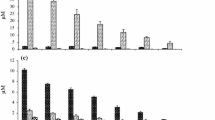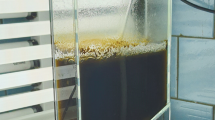Abstract
Extensive bloom of red tide, accompanying mass mortality of fish and the other animals, occurred in Bingo-Nada, the Seto Inland Sea, in August, 1970. Two species of microorganisms,Eutreptiella sp. andExuviaella sp., were isolated from the water and were obtained in axenic culture by micropipette washings.
These organisms are stimulated by trace metals. The highest growth resulted from the addition of chelated Fe (<3 mg/l) or/and Mn (<2 mg/l) to enriched sea water. The organisms prefer low salinity. The optimal salinities are Cl 8.0–17.0 ‰ forEutreptiella sp., Cl >11.0 ‰ forExuviaella sp. respectively. These organisms can tolerate a wide range of pH.Exuviaella sp. needs vitamin B12 for growth. The pattern of specificity toward B12 analogues2) is similar to that ofEuglena gracilis. On the other hand,Eutreptiella sp. requires B12, biotin, and thiamine. The B12 specificity fits toEscherichia coli. Both organisms prefer NH4-N in lower concentrations than 1 mg/l (optimal 0.3 mg/l) as nitrogen sources.Exuviaella sp. also likes urea. Inorganic and organic phosphates are utilized by the organisms:Eutreptiella sp. utilizes Na2-glycerophosphate, guanylic acid,Exuviaella sp. utilizes Na2-glycerophosphate, adenylic acid. KH2PO4 is the most favorable to the growth of both organisms. All the purines, pyrimidines, plant hormones tested increase the growth ofExuviaella sp. Especially, guanine, xanthine, thymine, indoleacetic acid, and gibberellic acid promote the growth remarkably.
These organisms do not grow to high densities without Fe or/and Mn in high concentrations even under the conditions provided by optimal temperature, salinities, pH, and essential nutrients. On the other hand, the coastal area of Fukuyama where the red tide first occurred has been fertilized with the nutrients essential to the organisms, and also polluted with trace metals such as Fe (Iwasaki, Inoue unpublished data). From these results, it can be considered that the great increase of the organisms is caused principally by the high concentration of iron in the sea water.
Similar content being viewed by others
References
1)(1969):Peridinium hangoei Shiller 16(2), 132–139.
Provasoli, L. (1963): in “The Sea II” (M. N. Hill ed.) Chap. 8, 165–219. John Wiley, New York.
Iwasaki, H. (1961): The life-cycle ofPorphyra tenera in vitro. Biol. Bull.,121, 173–187.
Sweeney, B. M. (1954):Gymnodinium splendens, a marine dinoflagellate requiring vitamin B12. Am. J. Botany,41, 821–824.
Iwasaki, H. (1965): Nutritional studies of the edible seaweedPorphyra tenera—I. The influence of different B12 analogues, plant hormones, purines and pyrimidines on the growth ofConchocelis. Plant Cell Physiol. (Tokyo),6, 325–336.
Neujahr, H. (1956): Vitamin in sewage sludge. IV. Isolation of new vitamin B12-like factors. Acta Chem. Scand.,10, 917.
Ramamurthy, V. D. (1970): Experimental study relating to red tide. Mar. Biol.,5, 203–204.
Author information
Authors and Affiliations
Rights and permissions
About this article
Cite this article
Iwasaki, H. Studies on the red tide flagellates—VI. Journal of the Oceanographical Society of Japan 27, 152–157 (1971). https://doi.org/10.1007/BF02109134
Issue Date:
DOI: https://doi.org/10.1007/BF02109134




